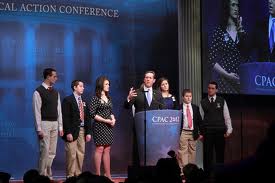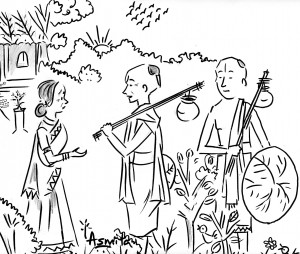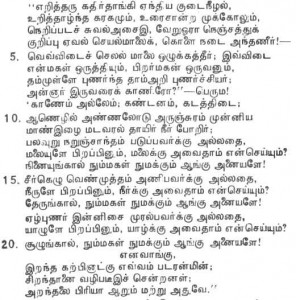Archive for category April 2012
Family Pictures in Political Rallies
Posted by admin in April 2012 on April 8, 2012
In this raucous primary season for the presidential elections, for a change, Republicans, known for their sedate intramural debates, are entertaining us with their mean-spirited name callings. After the elections in primaries, even those who come third and fourth deliver “victory†speeches, often with their families as backdrops. US politicians, unlike their counterparts in other democracies, surround themselves with their spouses and progeny in campaigns to reassure voters that they are honÂorable family men, which most of them are most of the time — and not scoundrels, which some of them are, some of the time for sure.
![]() Sen. Rick Santorum, father of seven children, and Gov. Mitt Romney, father of five sons, touted their family backgrounds using their wives and children as “optically“ effective props. Being seasoned pols, they contrastÂed themselves from their leading Republican threat at one point, Speaker Newt Gingrich, subliminally taunting him for his far from flawless conjugal life — three marriages, divorcing his first two wives under circumstances far from acceptable in candidates seeking the US presidency.
Sen. Rick Santorum, father of seven children, and Gov. Mitt Romney, father of five sons, touted their family backgrounds using their wives and children as “optically“ effective props. Being seasoned pols, they contrastÂed themselves from their leading Republican threat at one point, Speaker Newt Gingrich, subliminally taunting him for his far from flawless conjugal life — three marriages, divorcing his first two wives under circumstances far from acceptable in candidates seeking the US presidency.
The air-brushed photos of these candidates with large families stand in sharp contrast to married couples in the US having fewer and fewer children. Besides, college-educated married couples, irrespective of their religious affiliation and ethnicity, often have fewer children, someÂtimes, no children. Paradoxically, families from this slice of the population are the well-informed, having all the resources for raising kids.
 So, Romney (a Mormon) and Santorum (a Catholic), having large famiÂlies are exceptions because both are well educated and wealthy. So, RomÂney and Santorum are to be admired for having large families. DemographiÂcally that is exactly what we need. Our aging soÂciety is primed by service industry jobs. If we cannot get youngsters from our own population pool for these jobs — either because of the harsh working conditions or low pay (usually both) — there is no way we can avoid getting them from poorer nations, legally or illeÂgally. This is a global trend. Even in populous nations such as India, China, Mexico, and Brazil, there is huge influx of less-educated poor people from rural parts to urban centers, and from their neighboring countries.
So, Romney (a Mormon) and Santorum (a Catholic), having large famiÂlies are exceptions because both are well educated and wealthy. So, RomÂney and Santorum are to be admired for having large families. DemographiÂcally that is exactly what we need. Our aging soÂciety is primed by service industry jobs. If we cannot get youngsters from our own population pool for these jobs — either because of the harsh working conditions or low pay (usually both) — there is no way we can avoid getting them from poorer nations, legally or illeÂgally. This is a global trend. Even in populous nations such as India, China, Mexico, and Brazil, there is huge influx of less-educated poor people from rural parts to urban centers, and from their neighboring countries.
But all the family-value campaign rhetoric notwithstanding, US is not family-friendly for people to wanting have large families. The 6-week maternity leave for working mothers with newborn babies in the US is a scandal. In industrialized countries in Europe and Asia, and even in our neighboring Canada, maternity leave is for several months, with the mothers getting almost 80% of the salary. See here for getting a comparison:
www.catalyst.org/publication/240/family-leave-us-canada-and-global
Further, in urban centers across the nation, quality new-born and early childcare is prohibitively expensive (over %2500/month) for median-income working families. College education too is expensive.
After repeatedly seeing pictures of the Santorum and Romney families in campaign rallies, I wonder how the Family-Value conservatives and Teapartiers would react if they see pictures of large families of working class Blacks, Latinos or brown South Asians in the US in newspaper stories?
Or if they see minority working-class families with five or six kids in tow walking in shopping malls?
Or God forbid, if the Family-Value conservatives see legal minority parents with four kids in tow in grocery stores paying in Food Stamps at the checkout counters?
Also, ummmm… … one wonders if the current occupier of the White House would have even dared to seek the office if he and his wife had five or six children, a la Santorum and Romney?
Keeping Kids Culturally Connected
Posted by admin in April 2012 on April 8, 2012
Â
By Mona Chabra
e-mail: mona15143@yahoo.com
Note: A native of Pittsburgh, Mona earned her degree in Writing from Edinboro University of Pennsylvania and works as a freelance writer for Pittsburgh Parent Magazine.
When we think of culture many things come to mind. We can taste culture in the sweetness of baklava from the Middle East. We can see culture in the intricate designs of Japanese origami. Culture adds depth to our world and makes it unique. Culture shapes how we think and behave. Culture gives us a sense of belonging and identity.
But what do we do when distance comes between our cultural roots and the place we call home? It’s simple… just replant them!
That’s exactly what so many ethnic groups have done. Take our own for example! Most families of Indian origin take culture and tradition very seriously. From preparing authentic Indian food to speaking Hindi, Gujarati, Marathi, Bengali, Tamil… … Most families of Indian origin settled in Pittsburgh follow many Indian customs and traditions at home on a daily basis. By doing so, these customs and traditions, key elements of them, anyway, will be preserved from generation to generation.
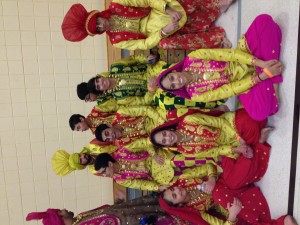 Like so many young people with multicultural backgrounds, good friends Amal Chabra and Sahil Dadoo recognize that it’s important for young people to stay connected to their cultural ethnicity so it can be passed on to coming generations. That’s why these kids have taken extra steps to hang on to their heritage. And, instead of sitting their cultures out, they’ve chosen to dance Bhangra, one of India’s most happening traditions!
Like so many young people with multicultural backgrounds, good friends Amal Chabra and Sahil Dadoo recognize that it’s important for young people to stay connected to their cultural ethnicity so it can be passed on to coming generations. That’s why these kids have taken extra steps to hang on to their heritage. And, instead of sitting their cultures out, they’ve chosen to dance Bhangra, one of India’s most happening traditions!
 “Though Bhangra is one of the most operose arts to perÂfect, there is nothing I enjoy more. It’s not only a lot of fun, but through the music, lyrics, costumes and moves, I learn a great deal about my Indian heritage,†says Amal. “My passion to reconnect with my roots has no limits!†Sahil agrees, “I think it’s important to for me to stay connected to my culture and traditions because then later on in life, I can pass these traditions down to other people and connect them to the Indian culture.â€
Bhangra is a buoyant and lively form of expression that will engulf you in its spirit as soon as you experience it. It’s a celebration of life and is done with zest, enthusiasm and energy.
Two well-established bhangra teams in PittsÂburgh are First-Class Bhangra (FCB) and (its younger verÂsion) First-Class Bhangra Juniors (FCBJ). Both groups have competed and performed in several venues throughout the US and are available to perform at both public and private events.
FCBJ currently consists of nine team members ranging in ages from fourteen to seventeen. But, according to the team’s leader/instructor, Ram Mahalingam, FCBJ plans to expand to enhance its stage presence for performances as well as competitions.
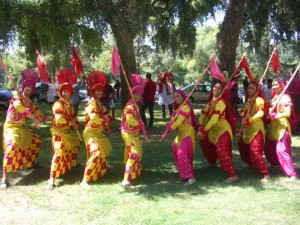 Born and raised in the US, Ram developed his passion for Bhangra at a young age. “I saw Bhangra as a hard dance style that provided me with a challenge, so I decided to give it a try.â€
Born and raised in the US, Ram developed his passion for Bhangra at a young age. “I saw Bhangra as a hard dance style that provided me with a challenge, so I decided to give it a try.â€
A recent graduate of the University of Pittsburgh, Ram has been actively involved in Bhangra for the past eight years. This year marks his fifth year of competitive Bhangra as well as teaching. ‘Being a teacher gives you so much joy when watching others and the success that they achieve. I think it’s great that the kids take such an avid interest in something that is culturally relevant to them. I do it for that love.†Ram says.
Ram also feels privileged that he can help bridge cultural gaps for so many kids just like himself. “I think it’s important for generations to get a taste of culture and try to understand why things are culturally important.â€
Ram has great expectations for FCBJ. “I know when their high school days are up this experience will have shaped them to be a model student and citizen at their colleges. They’re great kids and make me proud!â€
Lost in Translation — Almost!
Posted by admin in April 2012 on April 8, 2012
During the Cold War governments arbitrarily imposed and scrapped, raised and lowered import and export duties to punish and favor other countries or their own industries. The GATT (General AGreement on Tariffs and Trade) — which later evolved into the WTO (World Trade OrganiÂzation – wanted to stop this to stabilize trade among nations and interlink humanity for improving the quality of life and reducing the threat of large scale war. It came up with the policy that “a country should not discriminate between its trading partners (giving them equally ‘most-favored-nation’ or MFN status).†Granting MFN simply means that one nation will not arbiÂtrarily discriminate against others by erecting capricious trade barriers.
India granted Pakistan MFN status in 1996, but Pakistan did not reÂciprocate. But Indian goods enter Pakistan through Dubai at increased cost for ordinary working class Pakistanis. Smuggling of goods from India is also rampant. So, in November 2011, Pakistan decided to grant India the MFN status, which only means that Pakistan would treat India as it treats its all other trading partners.
But nothing is simple in India-Pakistan relations given the 70-plus years of bitterness – the Pakistan Resolution (1940); India’s colonial occupier Britain in 1947 hastily and arbitrarily partitioning the subcontinent into India and Pakistan; murder and rape of millions of Hindus, Sikhs and Muslims in the Partition; 3-1/2 wars (1947, 1965, 1971, and 1999); and the divergent understanding of the earlier Turkic/Persian/Afghani/Mongol invasions and the Mughal rule over India. The only thing common between the two are mutual suspicion, sense of betrayal, which often morph into hatred.
For Pakistan, it was difficult to sell the idea of granting the MFN status to India through the Urdu press dominated by the mullahs. Pakistani ofÂficials told their Indian counterparts that their biggest difficulty in granting MFN status to India is that its Urdu translation will create havoc. The Most Favored Nation status would be translated literally into Urdu as Subse Chahati Mulk, or Sabse Qaribi Mulk, or Sabse Pasandeed Mulk, or Sabse Inaayati Mulk, or Subsay Dularee Qaum. In Urdu, chahati, qaribi, pasandeed, inayati, and dulari respectively mean desired, closer, desired, favored, and darling.
These phrases, when taken literally by a population unfamiliar with the nuances of the history of WTO and international trade, would mean that the Pakistani government is getting cozy with India. In Pakistan, where hatred of India is part of the school curriculum, these Urdu expressions are triggers for the Islamic fundamentalists and the mullahs to cause trouble for the government. That is how things almost got lost in translation.
Finally, beginning 2013, trade between India and Pakistan would be normalized, insha Allah!! — By KSV
Book Review: Vivaha Samskara
Posted by admin in April 2012 on April 8, 2012
The Details Vedic Hindu Wedding
Reviewer: Praful Desai, Greensburg, PA
VivÄha SamskÄra – The Hindu Wedding Ceremony, by Deepak A Kotwal, Narayan B Datar, Arun D Jatkar, and Dilip Amin. Publishers: World Hindu Council of America, 2011 (161 pages). $12. Copies can be purchased at www.Hindu-Wedding.org, or at the SVTemple or the H-J Temple.
The book Vivaha Samskara was conceived, as Deepak Kotwal writes in the preface, when he wanted to understand the religious rites while organizÂing his own daughter’s marriage. The book, organized into chapters and appendices, begins with a discussion of the sixteen Vedic samskaras (rites of passage) and the four ashramas (stages of life) of the Sanaatana Dharma, describes the seven key elements of the Vedic vivaha ceremony.
The authors then unfold the symbolic significance of steps in the marÂriage ceremony, giving the hymns in Sanskrit with detailed instructions for conducting weddings. The authors also discuss interfaith marriages and offer young couples suggestions for avoiding potential conflicts because of differences in faiths. The final chapter and the several appendices give logistical details of the marriage ceremony.
The authors succeed educating and empowering Hindu young adults entering the married stage of life in offering a well-organized, clearly arÂticulated picture of the religious, spiritual and sociological significance of the marriage rites. The book fulfills the needs of both Hindu and non-Hindu families for understanding the Sanskrit-based Vedic marriage rites.
The authors invite couples embarking on grahasthashrama (householder stage of life) to regard the vivaha ceremony as a affirmation of their verbal commitment to each other into an indelible accord with community elders, while seeking blessings from the Vedic deities. Complete with the details of rituals and hymns in the Devanagari script with English transliteration and translation, the book is a good source for English-speaking people to grasp the Vedic wedding samskaras.
In writing the book the authors consulted with traditional Hindu priests from North and South India conducting marriages. This gives gravitas to the book as a reference for priests or anyone wishing to conduct a Vedic wedding. The authors maintain a fine balance between vivaha samskara, and their implications for moral guidance.
Finally, the book is a valuable contribution to Hindus and the growing number of intercultural families in the Diaspora as they strive to preserve the essentials of Sanatana Dharma in an ever-changing world. Vivaha Samskara would be an asset in every family library.
Book Review: “I Said it Too” on Diaspora Desis
Posted by admin in April 2012 on April 7, 2012
Reviewer:Â Premlata Venkataraman
I said It Too – Chai with Mahendra, a cartoon book by Mahendra Shah, Published by Mahendra Shah, 203 pages. Copies can be purchased ($20) from www.bookganga.com/eBooks/Books?BookSearchTags=i+said+it+too&BookType=1
Pittsburgh’s own Mahendra Shah, known to most readers of this magazine, has compiled several of his cartoons published in various forums, magazines, and dailies into a book “I said it too!”
Like the other world famous cartoon series You Said It by the celebrated Laxman in the Times of India, Mahendra Shah uses his wit and pencil to look at the Indian Diaspora’s hyphenated existence in the United States and bring into focus the absurdities such cultural mingling brings about.Â
His keen observations encompass our homes life, our parties and social interactions, our temple committees, and our growing distance from our children raised in this culture. Not one aspect of our lives – including our stinginess — has been left undisturbed by Mahendra Shah’s sharp mind. Â
 Shah’s cartoons offer as much commentary about our life here as those written in scholarly journals and opinion pages — except he does it with a few strokes and a pithy sentence that gently poke fun at our communities foibles and conflicted existence. His cartoons describe the pros and cons of attending events; high price of tickets; the larger effort of cooking halwa for 100 guests; the annoyance of attending multiple weddings for the same couple based on religious-cultural-regional differences. He also mocks at religious fanaticism and doctor/patient interactions, and editors (with rare exceptions) who treat him badly.
Shah’s cartoons offer as much commentary about our life here as those written in scholarly journals and opinion pages — except he does it with a few strokes and a pithy sentence that gently poke fun at our communities foibles and conflicted existence. His cartoons describe the pros and cons of attending events; high price of tickets; the larger effort of cooking halwa for 100 guests; the annoyance of attending multiple weddings for the same couple based on religious-cultural-regional differences. He also mocks at religious fanaticism and doctor/patient interactions, and editors (with rare exceptions) who treat him badly.
That both this book and the Vivaha Samskara reviewed elsewhere in this issue have been self-published by the authors is a sad reflection of ourselves, given that we brag about our high education, high earning power, and our high net worth.
These and similar works chronicle the life of Indian Americans in a new land, and hence are valuable source of information for someone in the future wanting to study the trajectory of Indian immigrants becoming part of the American mainstream.
An Evening of Poetry Reading in Hindi and Urdu
Posted by admin in April 2012 on April 7, 2012
By Ramona Sahni, Fox Chapel, PA
e-mail:Â ramonasahni@yahoo.com
Note: Ramona Sahni, a long-time member of the Indian community here, came to the US in 1971 as a resident in medicine. She and her husband Randhir Sahni live in the Fox Chapel area (Hartwood Estates).
Triveni International Club, which was dormant for some time, showed a splendid revival last Fall by sponsoring an enjoyable mushaira (creative poetry recitation) at the India Garden restaurant in Monroeville. It seemed like a divine intervention, the weather cooperated beautifully, no coats or umbrellas were required, and the food was fresh and wholesome. In the filled-to-capacity hall, the mood was expectant.
A diverse and renowned group of poets and authors enlivened the mushaira, a classical tradition of reading original Urdu poetry by Shairs and Shairas. Young and seasoned, men and women, hailing from different walks of life, read their verses, tastefully, often forcefully. There was also room for ribaldry. But all conveyed their passion, insight, and emotion. Men and women from our own area and those from neighboring states, some coming from Canada, and a few poets visiting from India delighted the packed lively audience.
The evening started promptly at 5 PM with appetizers followed by dinner. The program commenced at 7 PM instead of 7:30 PM as announced — a first for Pittsburgh! — to an eager crowd of patrons.Â
Participants adhered to the traditional boundaries of mushairas, which transported me to an age long gone — lighting of the candle by Shaheen Akhtar invoking the Divine illumination, nuanced approach to etiquette, and reverence shown to the Sadramushiara Maqsad Allahabadi — brought back memories of my younger days.
The poets used a colorful palette expressing love, pathos, loss & separation, longing for re-union, humor, satire and social themes. Everyone brought their unique life experiences into sharp focus in their recitals.Â
Credit goes to Durlabh Trivedi who organized this event almost single handedly. And what is a man without his wife? Santosh, Durlabh’s wife, hosted many of the artists at their home. Thanks go to Shaheen Akhtar and Hussein Imam for their efforts to get the artists, and to the Triveni board’s hard work, including the youngest member, Amit Grover. The program went on till late into the night.
The delightful evening made everyone introspective and nostalgic. We hope the Triveni Club continues to deliver this way, so we can all stay proud of our culture and heritage.
A Vignette in Indian Literature: Young Women Picking Their Own Mates not Unusual,
Posted by admin in April 2012 on April 7, 2012
By Kollengode S Venkataraman
Asmita Ranganathan of South Hills drew the sketches that nicely embellish the story.
In the last issue, Dilip Amin’s article elegantly persuaded readers – mostly Indian immigrant parents — to take in their stride interfaith marriages among their children. Amin also informed youngsters of the important issues they need need to sort out before, the issues they may gloss over during courtship.
Girls choosing their mates on their own is not unusual if you go by Indian legends. The story of Nala and Damayanti, among others, in Mahabharata is one example. In another, Shakuntala, the daughter of Kanwa rishi (sage), and prince Dushyanta fall in love, and even conceive a baby “out of wedlock” in today’s parlance. In other Indian literature too, young women falling in love with men is portrayed in diverse situations with all the intense emotions it generates.
Readers may know that Tamil, a stand-alone classical language like Sanskrit, Hebrew, Chinese, Latin and Greek, has a large collection of literature spanning over 2500 years, many of them now not extant. Kalittogai, whose time is before or around the beginning of the Common Era, is one such anthology of 150 free-style poems in classical Tamil, many dealing with love’s many fascinating manifestations portrayed in vignettes.
A verse in Kalittogai by king Perum-kadum-Ko, describes a situation that is contemporary for all ages. Ko in old Tamil means king. In ancient India, it was expected that kings, powerful landowners, and rich merchants be trained in the aesthetics of literature, music, and dance. Naturally, many of them were patrons of arts. This Kalittogai poem is set in a fascinating backdrop:
A middle aged woman, the mother of a young adult daughter, finds at daybreak that her grown-up daughter is not home. She remembers seeing her daughter going to bed the previous night. She knows that her daughter was in love with a young man in the neighborhood. Not finding her daughter, the mother panics that she might have left the village with her lover. Looking for her daughter in panic along the pathway leaving the village, she sees a group of Brahmin ascetics walking briskly towards her.
How does she know they are Brahmins? Well, they are carrying a Tri-Dandam (a stick made by tying together three branches of a special tree) carried by Brahmin sannyasis even today, to which they have tied their alms-collecting bowls (bhiksha-patram).
The poem is composed as a conversation between the panicked mother and the wayfaring Brahmin recluses on a pilgrimage:
“O Brahmins, with a tri-dandam on your shoulder to which you have tied your alms-collecting bowl, and carrying umbrellas to shield against the hot sun, your single-minded brisk walk and demeanor tell me you are on a pilgrimage. Along way you came by, did you see my daughter and a stranger’s son walking together in love with each other?”
“We cannot say we did not see. O mother of the attractive, courageous young woman who chose to leave with a young, handsome man! We did see them walking past us! Panic not! Now listen:
“Fragrances growing in the forest on the hill only benefit the people who daub themselves with their pastes. What use are the fragrances for the hill? Coming to think of it, your daughter too is like that to you.
“Lustrous pearls growing in waters beautify only those who wear them. What use the pearls have for the waters? Coming to think of it, your daughter too is like that to you.
“The melodic music coming from the seven-stringed yaazh (a harp-like ancient Tamil instrument not available now) is only for those who enjoy its music. What good is the music for the yaazh itself? Coming to think of it, your daughter too is like that to you.”
Comforting the panicked mother thus, the wayfaring Brahmins reassure her further: “You return home in peace of mind. And do not be in grief thinking that your daughter has run away. She is a virtuous woman. Do not cause her any harm. She has gone with a good and honorable man. Her actions do not violate the Natural Order of things in life.”
Now when we put this 2000-year old verse’s import in the context of Dilip Amin’s suggestions and counsel in the last issue to parents and youngsters contemplating interfaith marriage, we see a fascinating continuum between Amin and the Brahmin ascetics.
The Kalittogai verse is cast in the context of a mother’s panic on her daughter choosing her life partner on her own. However, the imageries in the Brahmin ascetics’ advice to the panicked mother are as much valid to situations in which our young men and women choose their life partners on their own, much to the anguish of their parents.
For those who can read Tamil, the original Kalittogai verse is given below*. If you can read Tamil, you will find that this classical Tamil is very different from your day-to-day contemporary masala Tamil, or even the Tamil you read in popular magazines. If you plough through reading it, I am sure you will appreciate its literary nuances.
Â
Celebrating Tagore’s 150th Birth Anniversary
Posted by admin in April 2012 on April 7, 2012
Nidrita Mitra Sinha & Samar Saha
e-mail: nidrita26@gmail.com & samar_k_saha@yahoo.com Â
Sri Venkateswara Temple auditorium was packed on Saturday, November 26 last fall to celebrate Rabindranath Tagore’s 150th Birthday Anniversary. Pittsburgh Indians paid tribute to their great poet through Tagore’s poems, songs, and his dance-drama Chitrangada by the students of Nandini Mandal’s Nandanik Dance Academy.Â
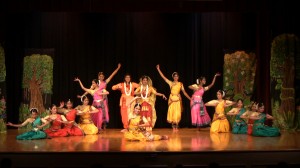 The first part was presented with a garland of three poems and three songs, each accompanied by dances expressing the sentiments of Puja (Devotion), Prakriti (Season/Nature), and Prem (Love) – three themes of Tagore’s forte.
The first part was presented with a garland of three poems and three songs, each accompanied by dances expressing the sentiments of Puja (Devotion), Prakriti (Season/Nature), and Prem (Love) – three themes of Tagore’s forte.
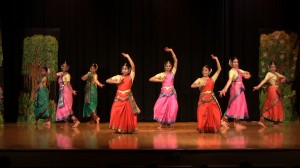 The poetry recitations, by Sujatha Sundar (in Tamil translation), Maneesha Cleetus (in Hindi translation), Nidrita Mitra-Sinha in Bengali original, and Nandini Mandal in English translation, brought out the true emotions of each poem. The choreography for the dance was excellent and the supporting dances performed by Poorwa Godbole, Mohini Walavalkar, Roosha Mandal and other younger adults went well to set the mood for the next part.
The poetry recitations, by Sujatha Sundar (in Tamil translation), Maneesha Cleetus (in Hindi translation), Nidrita Mitra-Sinha in Bengali original, and Nandini Mandal in English translation, brought out the true emotions of each poem. The choreography for the dance was excellent and the supporting dances performed by Poorwa Godbole, Mohini Walavalkar, Roosha Mandal and other younger adults went well to set the mood for the next part.
In the second part, Tagore’s dance drama Chitrangada was presented. Tagore wrote Chitrangada in 1892 when he was barely 32. But the storyline is as compelling today as it was then.Â
The story of Chitrangada is a small episode in the ageless Hindu epic Mahabharata. The story in its original form is distinctly macho and reads like another conquest of Arjuna. But Tagore took the story, gave it a feminine twist, and transformed it into a modern musical. Tagore retold the story with a remarkable fusion of oriental and occidental ideas on the femininity with a vision that sensual love may begin its bloom as an entrapment created by our sensory perception of external beauty and youth. But after the initial bursts are over, love is freed from that illusion into the greatness of austere truth that a love which never learns to go beyond the physical appearance knows no real fulfillment, no peace, and is, therefore, unreal. Â
Chitrangada’s feminist undertones, subtle emotions, messages, and Tagore’s own poetic sweep over the original story demanded only the best out of the performers. And the members of the Nandanik Dance Academy did deliver. The participants gave their best in bringing this masterpiece to life. Nandini Mandal as the director, choreographer, costume designer, and prima ballerina was simply outstanding. It was a moving experience to observe how warrior princess Chitrangada (Nandini) and her alluring incarnation (Mohini) put their heart and soul to bring out the agonies and ecstasies of love in each act.
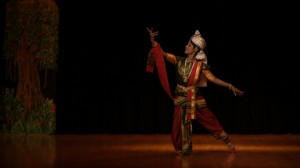 Their every move, facial expression and body sway fluidly poured out the emotions embedded in the story.
Their every move, facial expression and body sway fluidly poured out the emotions embedded in the story.
The songs recorded in India under the direction of Late Roma Mondal, and narrations by Pittsburgh’s own Brita Chakrabarti were commendable. The dancers brought out the real emotions with every musical note.
The dances presented in Manipuri, Kuchipudi, Bharatnatyam, and Kathakali styles with tastily done costumes, simply added to the grandeur and elegance to the play. The colorful costumes uniquely blended with the mood of the songs and with each act.Â
Aparna Roli Nigam’s performance as Arjun of Mahabharata needs special mention as she brought out the male emotions impressively. Similarly, the performances of Rachana Lanka as god Madana and the little children in the Deer Dance were adorable. The technicians managing the audio and lights should be thanked for a job well done.  n
Nritya Sangam : confluence of four classical Indian dance forms.
Posted by admin in April 2012 on April 7, 2012
 by Nandini Mandal, Mt. Lebanon, PA
e-mail: nandini@nandanik.net
Nritya Sangam, an Indian classical dance program organized last fall organized by Kamala Reddy’s Kala Niketan showcased four classical dance styles of India – Kathak (by Sudeshna Maulik), Odissi (by Shibani Patnaik), Kuchipudi (by Kamala Reddy) and Bharatanatyam (by Sruti Javali). The recital at the Shady Side Academy’s Fox Chapel campus on Saturday, December 3, captivated the nearly packed auditorium of ticket buying audience on that nippy evening.
 The Evening started with a Pushpanjali. Sruti set the mood with a prayer to Ganesha in Shankarabharanam followed by Shibani’s prayer to Brahma, the creator, rendered in Vaasanti. Reddy followed with a piece in praise of Vishnu with the music set in Shuddha-saveri. And Sudeshna paid obeisance to Nataraja and Durga, with the verse rendered in Mishra Kafi. Towards the end, the four dancers appeared together on stage giving the recital in their own distinct styles for the same melody (in Desh) and laya (rhythm) patterns as the finale to the Pushpanjali.
 Sruti Javali followed with her Shadakshara Kautuvam, choreographed by Priyadarshini Govind, in which the dancer elegantly used Madurai Muralidharan’s signature composition on Kartikeya. Shibani Patnaik‘s Varsha Varnalee next described the cyclical journey of water rising as dark clouds from the ocean; and moving over land, become rain drops and then heavy rains; the rain water flows in streams becoming gushing rivers softly merging into the ocean. And the ocean water again rises as clouds, with the whole sequence resembling the cycle of life itself. This Odissi piece was original in thought and presentation, while firmly rooted in its classical idioms. The first half ended with a collage of episodes from the life of Krishna.
 The second half opened with the Ananda Tandavam by Kamala Reddy in Kuchipudi style. Reddy presented Shiva Tandavam with crisp razor-sharp movements and freezes keeping the audience engrossed.
 This was followed by Sudeshna Maulik’s Kathak Swaroop, presenting the nritta aspects of Kathak. Expecting the traditional “idioms” of Kathak (as mentioned in the brochure) in this piece, I was kind of disappointed. The costume also was a little too innovative for the traditional nature of presentation of the other styles. Sticking to tradition would have fitted well, given that the audience got to see the four different styles together after a very long time.
 The seven dance styles of India – all based on the same essentials in the Natya Shastra — are yet unique not only in form and technique, but also in costume, presentation, musical repertoire. Sudeshna is a talented, young dancer trained by the likes of Guru Rani Karnaa, Pandit Birju Maharaj, and Sri Jaikishen Maharaj. Her sharpness of angik, or technique, was brilliant. So, expectations were more from her.
 The highlight of the evening was the final presentation of Samvad — a dialogue in laya in a blend of Tillana and Tarana. The dancers used elaborate geometric patterns to traverse the entire stage space. This presentation was the perfect culmination of dance and music for the evening. The conversation among the adavus of Bharatanatyam and arasas of Odissi, the tukras of Kathak and the jatis of Kuchipudi was spellbinding. The recital ended with the Shanti mantra. A perfect melbandhan.
 As we all know, nritya-geet-vadya (dance, music and rhythm) go hand in hand. Dance especially is dependent on lyrics, melody and rhythm. The music for the evening’s recital was simply mind-blowing. It is a dancer’s dream to dance to music of such richness. This being the case, except in one item, nowhere during the show, or in the brochure were the composers’ or musical ensemble’s details mentioned.
 For such an elegant and resourceful auditorium, the general lighting was also quite wanting.
Â
Â
Ha! Ha!!
Posted by admin in April 2012 on April 7, 2012
 From Classical Sanskrit Poetry (only in translation)
 On Wealth:
 What you give to charity
and what you use for day-to-day
 That I hold your wealth to be.
 The rest, with someone else will stay.
Â
 With a hoarder’s wealth others toy —
 It is like honey, which some amass,
 while others enjoy.
 — Bana Bhatta (7th Century) Sanskrit poet
Â
For Ron Paul’s and other Tea Partiers’ Delight:
 If the bureaucrat could never eat
 his mother’s flesh while in her womb,
 the only reason for this feat was,
 at that time, he had no teeth!
 — Prakashavarsha (9th century) Sanskrti poet A.N.D. Haksar’s translation of
 Subhaashitaavali
(Penguin Classics, 2007).
Â
Money causes pain in getting;
 In the keeping, pain and fretting;
 Pain in loss and Pain in spending.
 Damn, the pain never ending!
 — From the Panchatantra
(2nd Century AD), A W Ryder

